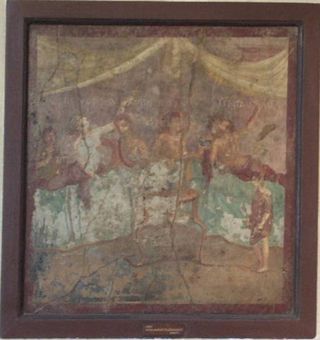A Roman (sort of) word play: House of the Triclinium, Pompeii.
One basic message, as I have often banged on about, is that you never lose by looking at the real thing.. you always see more if you see some ancient object in real life, than if you just look at the pictures in the books. The next most basic message is that if you look at something again and again, you see even more.
Last week I went with two of my "mobility challenged" mates to see the Pompeii exhibition, which I have seen a load of times before, and saw more in one or two objects than I have ever seen before.
The piece in question is a painting from the House of the Triclinium, one of a few from there which show a dinner party in full swing. Interestingly, this has a nicely written text above the characters (obviously contemporary with the picture, not later graffiti. And there is more to it than meets the eye.
What you have (and I am really sorry it's not a better pic, couldn't find one at all),written above the heads of the diners is a glimpse of the banter at dinner.
From the left it reads "Facite vobis suaviter".. "Have a gorgeous time". Then the guy in the centre says "Ego canto".. "I'm singing/I'm going to sing".
Then it gets more complicated.
The Latin reads. EST ITA V (then the raised hand of the diner interrupts) ALEA
The translation in the show says that this means "Yes, you go for it.."
Fine, but in order to make it mean that, you have to imagine that the Latin reads "Est ita vale", or (as the CIL has it) "Est ita valeas".
But it doesnt actually say that. There is definitely an A after "...ale", and there is no sign of an S.
I am strongly tempted to thing there is a word play going on here. "EST ITA V.." is what you first see. And your first instinct before you have looked right to the end, it to think you are going to see VALE... Except that what you see after the raised hand is ALEA, the Roman word for dice, and another firm favourite of the dinner party. So is it VALE.... or ALEA (come on lets have a game of dice)? Or both?
The guy's raised hand is the clue. And (as both the husband and the son have pointed out) another bit of the joke is that the guy's hand appears to be raised in such a way as to make a Roman V (a five)... nicely following the V (of VALE..). So it's a 5 and a V and a VALE and an ALEA..
CleVer .. eh?
Mary Beard's Blog
- Mary Beard's profile
- 4112 followers




